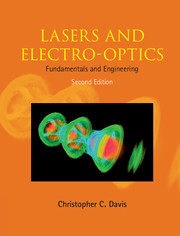Book contents
- Frontmatter
- Contents
- Preface to the Second Edition
- 1 Electromagnetic waves, light, and lasers
- 2 Optical frequency amplifiers
- 3 An introduction to two practical laser systems
- 4 Optical resonators containing amplifying media
- 5 Laser radiation
- 6 Control of laser oscillators
- 7 Optically pumped solid-state lasers
- 8 Gas lasers
- 9 Molecular gas lasers I
- 10 Molecular gas lasers II
- 11 Tunable lasers
- 12 Semiconductor lasers
- 13 Passive optical systems
- 14 Periodic optical systems, resonators, and inhomogeneous media
- 15 The optics of Gaussian beams
- 16 Optical fibers and waveguides
- 17 The optics of anisotropic media
- 18 The electro-optic and acousto-optic effects and modulation of light beams
- 19 Introduction to nonlinear processes
- 20 Wave propagation in nonlinear media
- 21 Detection of optical radiation
- 22 Coherence theory
- 23 Laser applications
- Appendix 1 Optical terminology
- Appendix 2 The ´-function
- Appendix 3 Black-body radiation formulas
- Appendix 4 RLC circuits
- Appendix 5 Storage and transport of energy by electromagnetic fields
- Appendix 6 The reflection and refraction of a plane electromagnetic wave at a boundary between two isotropicmedia of different refractive indices
- Appendix 7 The vector differential equation for light rays
- Appendix 8 Symmetry properties of crystals and the 32 crystal classes
- Appendix 9 Tensors
- Appendix 10 Bessel-function relations
- Appendix 11 Green's functions
- Appendix 12 Recommended values of some physical constants
- Index
- References
14 - Periodic optical systems, resonators, and inhomogeneous media
Published online by Cambridge University Press: 05 June 2014
- Frontmatter
- Contents
- Preface to the Second Edition
- 1 Electromagnetic waves, light, and lasers
- 2 Optical frequency amplifiers
- 3 An introduction to two practical laser systems
- 4 Optical resonators containing amplifying media
- 5 Laser radiation
- 6 Control of laser oscillators
- 7 Optically pumped solid-state lasers
- 8 Gas lasers
- 9 Molecular gas lasers I
- 10 Molecular gas lasers II
- 11 Tunable lasers
- 12 Semiconductor lasers
- 13 Passive optical systems
- 14 Periodic optical systems, resonators, and inhomogeneous media
- 15 The optics of Gaussian beams
- 16 Optical fibers and waveguides
- 17 The optics of anisotropic media
- 18 The electro-optic and acousto-optic effects and modulation of light beams
- 19 Introduction to nonlinear processes
- 20 Wave propagation in nonlinear media
- 21 Detection of optical radiation
- 22 Coherence theory
- 23 Laser applications
- Appendix 1 Optical terminology
- Appendix 2 The ´-function
- Appendix 3 Black-body radiation formulas
- Appendix 4 RLC circuits
- Appendix 5 Storage and transport of energy by electromagnetic fields
- Appendix 6 The reflection and refraction of a plane electromagnetic wave at a boundary between two isotropicmedia of different refractive indices
- Appendix 7 The vector differential equation for light rays
- Appendix 8 Symmetry properties of crystals and the 32 crystal classes
- Appendix 9 Tensors
- Appendix 10 Bessel-function relations
- Appendix 11 Green's functions
- Appendix 12 Recommended values of some physical constants
- Index
- References
Summary
Introduction
In this chapter we shall use a variety of analytic techniques to analyze periodic optical systems and understand their behavior. These are optical systems in which a ray crosses a repeating pattern of interfaces, a so-called stratified medium, or passes through a sequence of optical components that repeat in a periodic fashion along the axis.
These periodic systems include multi-layer structures that have special reflective or transmissive properties and structures whose dielectic properties vary symmetrically in two or three dimensions. Such periodic structures are often called photonic crystals. Periodic lens sequences are axisymmetric arrangements of multiple lenses arranged along an axial direction. They can be described as stable or unstable. Stable lens sequences have the ability to confine a propagating bundle of rays near to the axis in such a way that the rays never deviate by more than a certain finite distance from the axis and remain confined. Periodic lens sequences can also be used to study the paths of light rays bouncing back and forth between pairs of mirrors – optical resonators. This will allow us to deduce the stability condition for such resonators.
Plane waves in media with complex refractive indices
The relative permittivity and the relative permeability characterize a medium in terms of its difference from a vacuum. Most materials that are important in a discussion of lasers and optical devices are not strongly magnetic, and it is generally legitimate to assume that for such materials μr = 1.
- Type
- Chapter
- Information
- Lasers and Electro-opticsFundamentals and Engineering, pp. 409 - 437Publisher: Cambridge University PressPrint publication year: 2014



